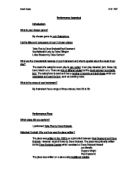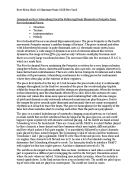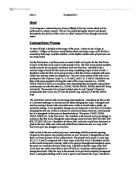Moon children
Moon
Blues Music
Blues Music Blues Music began as songs sung by black slaves in the mid - 19th century in the Southern United states. It has taken elements from African, European and American folk music. After the Civil War and emancipation the Blues spread, together with the species that sang and played it, from the cotton fields of the southern states to northern cities such as Chicago and Detroit, where the music became hugely popular. The notes in the blues scale are very dissonant. This may be because the black slaves were in misery working all day, and the scale represents their feelings. In the scale of C, the notes in the blues scale are: ______________________________________________________________________________________________________________________________________________________________________________________________________________________________________________________________________________________________________________________ This is the chord sequence in 12-bar blues music. It is still sometimes heard in popular music today. Chord of Chord of Chord of Chord Bars 1 - 4 C C C C Bars 5 - 8 F F C C Bars 9 - 12 G F C C Blues music has many characteristics in its melody that makes it typical to the style. It often rolls between 2 notes, and sometimes there is a glissando, which is sliding from one note to another. Blues music may also
Symphony number 45 in F# minor (the
Symphony number 45 in F# minor (the "Farewell symphony") Between 1761 and 1790 Haydn was employed by the enormously wealthy Esterhazy family who had two palaces on the borders of Austria and Hungary. The court orchestra was similar to that of many baroque orchestras - two oboes, a bassoon, a string ensemble and a harpsichord. But it also included a pair of horns - instruments that became a regular part of the orchestra thereafter. It was this orchestra that accompanied operas in the palace theatre and played symphonies twice a week. Haydn's symphony number 45 in F# minor was first performed in the summer prince Nikolaus Esterhazy and his household lived in their Hungarian palace where wives of his musicians where not allowed to stay. The usual date for the prince's return to his Austrian palace and the reunion of his instrumentalists and their wives had long past. The orchestra asked Haydn to speak to the prince, but instead Haydn wrote a symphony that ended quite unusually, with a slow movement designed to allow the musicians to leave in ones and twos until only two violinists were left. When they finished playing they too blew out their candles and left. The prince took the hint and ordered immediate preparations fro a return to Austria. The importance of the Farewell symphony lies in the way that Haydn uses the formal structure of the symphony to express an astonishing
music genres
electro: Electro, short for electro funk (also known as robot hip hop and Electro hop) is an electronic style of hip hop directly influenced by Kraftwerk and funk records. Records in the genre typically have electronic sounds and some vocals are delivered in a deadpan, mechanical manner often through a vocoder or other electronic distortion. artists: mandroid, planet partrol, I-F, man parrish, arpanet, cybotron. clips: man parrish, hiphop bebop: http://www.youtube.com/watch?v=UHBA4ly_X7Q I-F, secret disire: http://www.youtube.com/watch?v=vICSM7a53MM stylistic origins: synthpop, disco, funk and old school hip hop. cultural origins: early 1980s, in the US mainstream popularity: mid to late 1980s and then a revival in the late 1990s. instuments used: synthesizer, drum machine, vacoder and a sampler. some subgenres include: electro bass, freestyle music, miami base, techno bass and minimal electro. Blues: Blues is a vocal and instrumental form of music based on the use of the blue notes. It emerged in African-American communities of the United States from spirituals, work songs, field hollers, shouts and chants, and rhymed simple narrative ballads. The use of blue notes and the prominence of call-and-response patterns in the music and lyrics are indicative of African influence. The blues influenced later American and Western popular music, as it became the
Roosevelt Sykes - biography
Roosevelt Sykes - biography Also known as: The Blues Man, Dobby Brag, The Honeydripper, Easy Papa Johnson " Roosevelt Sykes is one of the most important urban bluesmen of all time." - Bob Koester, Delmark Album DL - 607 " [In the 40s]he recorded important transitional records that bridged the gay between Southern rural blues and the modern, electric Chicago blues style." - Don Heckman, BMI: The Many Worlds of Music" 1969, p.26 Roosevelt Sykes was born on 31 January 1906, Elmar, Arkansas, USA and died on 17 July 1983, New Orleans, Louisiana, USA. His father was a musician and all his brothers (Johny, Willie, Walter) Sykes learned piano (self-taught) at the age of 12 and frequently played the organ in the local church. Ran away from home in order to work. By the early 20s was playing in local barrelhouses. He moved to St. Louis in 1928, worked in Jazzland Club, and his first recordings for OKeh Records and Victor Records were made from 1929-31. During the 30s, Sykes recorded for Decca Records and acted as a talent scout for the label. Among his most popular compositions were "Night Time Is The Right Time" and "The Honeydripper', which was Sykes" nickname, because he was a known ladies-man. At that time he also played in local clubs in Memphis and later in such in Chicago. In the late 1930s teamed with St. Louis Jimmy to tour one-nighters across the U.S.. He settled in
Create a questionnaire to find out what type of music people listen to.
Statistics Coursework. The Task: * My task is to research into the music industry and then create a questionnaire to find out what type of music people listen to. I will then need to record the results and create some sort of interpretations of the data to see if the results match my hypothesis. Hypothesis: . Most People in year 11 listen to drum and bass. 2. Year 11 spend more money on music than year 7. 3. New Metal/ Grunge music is the most unpopular genre of music in school. * I think that most people in year 11 listen to drum and bass because it is now a growing, popular style of music and now is becoming a dominating genre of music. * I think that year 11 spend more money on music that year 7 because year 11's grew up loving music more. Year 7's are more interested in technology than what they are in music. * I think that New Metal/ Grunge music is the most unpopular style of music in school because nobody really likes that style of music unless they like being called names and also the music is quite heavy to listen too. It's too hard on the ears. Introduction: * We as a group decided who should be within our group by thinking who the hardest workers are and who would actually want to do the work. The three of us (Barry Boston, James Bolton and Minesh Patel) are also friends so we knew that we would get along with each other. We thought this would be the
How far did all Americans share in the prosperity of the 1920's?usa
How far did all Americans share in the prosperity of the 1920's? In the 1920s the USA went into a period of prosperity. The economy did very well, money wise; in the 1920's everyone seemed to be having fun and enjoying the prosperity. A few features that came because of the prosperity were the Jazz Age, Flappers and Speakeasies. The 1920's were called the 'Jazz Age' because jazz music was the most popular music; the young people enjoyed this music because it was new and exciting. Along with the music came new dances. There were some people who disliked the jazz music, this was because they thought the music was sensuous and embarrassing, and then they thought that the dancing was absolutely indecent especially for the young ladies to be doing. Many other people disliked the 'jazz age' because the artists of the music were mostly coloured or black. During the `Jazz Age' flappers came about. They were young ladies who would shock older people by doing things that they opposed. Flappers liked to wear short skirts, backless gowns and silk stockings rolled just above there knees. Smoking cigarettes in public, holding there partners hand without gloves, some had even had sex before they were married; they also would get there hair cut by men's barbers all these things had shocked the older people and their parents because they were very unladylike. While most people were
My chosen genre is Jazz Saxophone.
Performance Appraisal Introduction What is your chosen genre? My chosen genre is Jazz Saxophone. List the titles and composers of your 3 chosen pieces Take Five by Dave Brubeck/Paul Desmond Sophisticated Lady by Duke Ellington Lotus Blossom by Dave Sanborn What are the characteristic features of your instrument and what is special about the music it can play? The music the saxophone can play is very varied. It can play classical, jazz, blues, big band, March e.t.c. There are lots of different styles but the most common is probably jazz. The saxophone is used as it has a number of sounds and techniques which are associated and used for jazz, such as bending notes. What is the range of your instrument? My instrument has a range of three octaves, from Bb to Bb: Performance Piece Which piece did you perform? I performed Take Five by Dave Brubeck. Historical Context: Why and how was the piece written? The piece was written in the 1960's as a joint effort between Paul Desmond and Dave Brubeck. However, most of it was by Dave Brubeck. The piece was primarily written for the Dave Brubeck Quartet which consisted of: Dave Brubeck himself Joe Morello Eugene Wright Paul Desmond The piece was written on a stave using traditional notation. What is the style of the piece? The style of the piece is bluesy/jazzy and swung. What are the main features of the style? The
Integrated Task Commentary. For my performance I have chosen a Trinity Guildhall Grade 5 piece called Lime Tree Bay. It is a jazz piece composed by a session musician and composer called Malcolm Ball. I will play my own interpretation of this particular p
INTEGRATED TASK COMMENTARY For my performance I have chosen a Trinity Guildhall Grade 5 piece called Lime Tree Bay. It is a jazz piece composed by a session musician and composer called Malcolm Ball. I will play my own interpretation of this particular piece of music, which differs subtly in the "feel" from the way Malcolm ball plays it. Malcolm Ball's version lacks a degree of subtlety in the way it played, which modifies the way it sounds and the emotions conveyed. I believe my version is truer to the way traditional jazz is played which was reflective of the black people's liberation in back street clubs (the birthplace of jazz). Malcolm Ball's piece only provided a template for the piece which could be developed by the performer, acknowledging the supposition that a piece of music, much like a book can be interpreted in a variety of ways. The first twenty five bars are performed using brushes; this is not dissimilar to the way many big band pieces were played and so shares properties of both big band and traditional jazz. The use of brushes makes it easier to differentiate between accented notes and long legato "sweeps" on the snare drum, giving the piece a variance in timbre making the piece more interesting. It is difficult to sustain a homogenous sound that doesn't vary at the apex of the stir. Instead I chose to embrace the issue and accentuate the apogee of the
Synth-Pop Coursework. Synthpop is a genre of music that first became noticeable in the 1980s, this was when the synthesizer was the dominant musical instrument.
Synth Pop - BTEC Music Coursework Introduction To Synthpop Synthpop is a genre of music that first became noticeable in the 1980's, this was when the synthesizer was the dominant musical instrument. This style of music became very popular in Japan and the United Kingdom during the post-punk era and became a part of the "New Wave" movement of the late 1970's to the mid 1980's. Some of the first synthpop musicians included Japanese group Yellow Magic Orchestra and British bands Ultravox and the Human League. These groups largely used monophonic synthesizers to produce music a simple and unique but exciting sound. What Is Synthpop? Synthpop is a unique genre of music like no other due to its futuristic and electronic sound. It uses synthasisers as its main and sometimes only instrument. Artists such as Kraftverk and Depeche Mode are some of the more well known groups to produce synthpop music. Many synthpop musicians had limited musical skills, relying on the technology to produce or reproduce the music. The result was often songs that were simple repeated riffs repeating themselves. Themes that were often used when writing a synthpop song were isolation, urban anomie, and feelings of being emotionally cold and hollow. Lets Go Back To When It All Started Electronic musical synthesizers that could be used in a recording studio became available in the mid 1960 and it was

























